
MIS PARTIDAS DE AJEDREZ: Un encuentro con un viejo rival (Gutiérrez, Jhonattan vs Revilla, Oniel)
(Versión en español | Spanish Version)
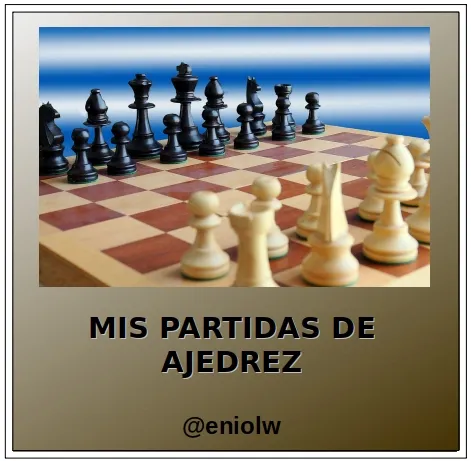
Este post es parte de una serie dedicada a la publicación inédita de una porción de mis partidas de ajedrez que he jugado a lo largo de mi carrera. Estas consisten, en su gran mayoria, en partidas de competencia y de torneos, como también partidas amistosas selectas, de entrenamiento, de simultánea, etc. Serán importadas a lichess.org y también publicadas aquí en la blockchain, aspirando con ello dejar una huella indeleble de su existencia.
Estos artículos incluirán, claro está, mis propias anotaciones, análisis y reseñas de las partidas en mi condición de jugador y entrenador de ajedrez. Por su naturaleza, la mayoría de los análisis requerirán que el lector tenga ciertos conocimientos de ajedrez, pero en muchos casos tan solo conocer la notación ajedrecística debería ser suficiente. Su contenido de seguro resulta ser de utilidad para los ajedrecistas estudiosos (profesionales o aficionados) y me alegra saber que pueden venir a la blockchain y a #FullDeportes para consultarlas.
Un encuentro con un viejo rival
La partida que presenciaremos se jugó en el año 2007 en la histórica escuela de ajedrez Ernesto Guevara ubicada en el Teatro Armonía de Coro, estado Falcón, Venezuela. El torneo fue uno de los más importantes que la escuela de ajedrez tuvo el honor de hospedar puesto que, aunque era un torneo local y clasificatorio, logró reunir durante dos fines de semana a muchos de los mejores ajedrecistas del estado, quienes por distintas razones no habían jugado un torneo juntos en bastante tiempo.

Mi persona durante el clasificatorio regional para los Juegos nacionales de Los Llanos 2007, el cual tuve la grata ocasión de ganar en solitario, siendo una experiencia que atesoro mucho en mi carrera. Estaba jugando en la primera mesa, casualmente junto al oponente de la partida protagonista de este post.
Mi rival es Jhonattan Gutiérrez, quien para la época estaba reactivándose tras un retiro del ajedrez por unos años y, al ser mi contemporáneo, era mi principal rival en nuestra categoría. Actualmente pueden conseguirlo en Lichess con la cuenta Jhonattan2106. La partida era clave porque resulta que Jhonattan era de los más fuertes jugadores presentes y, de hecho, él culminó el torneo empatado en el segundo lugar. Veamos la partida.
1. e4 c6 La Defensa Caro Kann era mi principal arma con negras en esa época. Estaba notablemente influído por Anatoli Kárpov, el más famoso exponente de esta defensa, aunque la primera vez que la vi fue en la "infame" partida entre Deep Blue y Kasparov donde el campeón humano perdió. 2. d4 d5 3. exd5 cxd5 4. c4 Este es el ataque Pánov, el arma predilecta de mi adversario. 4... Cf6 5. Cc3 e6 La alternativa es jugar con 5... Cc6, pero me gusta más la de la partida.
Siguió 6. Cf3 Ab4 7. Db3?! Esta es una línea secundaria que no promete nada para el blanco. Sin embargo, no puedo decir que no me sorprendió, ya que para la época yo no era un teórico de aperturas. Actualmente me pregunto si las blancas entendieron la posición como una especie de variante Capablanca en la Nimzoindia. Lo mejor es continuar con 7. cxd5 Nxd5 8. Ad2 lo cual ha sido puesto a prueba miles de veces. La partida siguió con 7... Cc6 8. a3 y bueno, las blancas evidentemente quieren forzar los asuntos, pero ello no funciona bien... en teoría (ver diagrama).
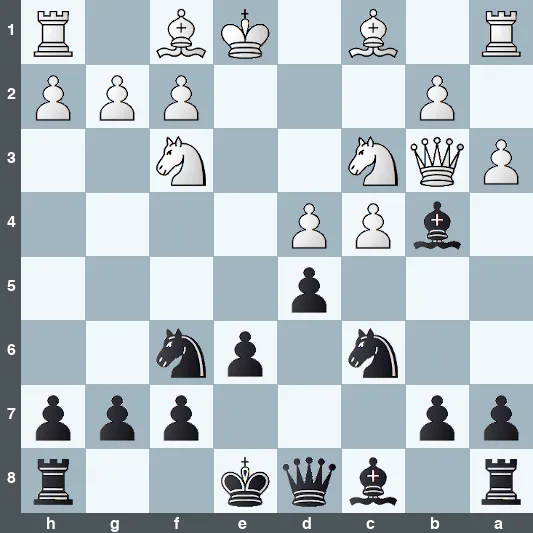
Posición #1: La jugada 8. a3 es teóricamente inofensiva y las negras pueden sacarle jugo de forma muy específica. ¿Cuál?
8... dxc4 no así, ciertamente. No di con el orden de jugadas aprobado por la teoría. Lo mejor era continuar con 8... Axc3+ 9. Dxc3 Ce4! y la clave es que las negras pueden forzar un final favorable mediante 10. Dc2 Da5+! 11. Ad2 Cxd2 12. Dxd2 Dxd2+ 13. Rxd2 Ca5! (amenaza Cb3+) 14. Rc3 dxc4 15. Axc4 Cxc4 16. Cxc4 b6! y las negras tienen mejor estructura de peones y mejor combinación de piezas de cara a este final. En todo caso no me siento tan arrepentido acerca de mi decisión porque definitivamente quería ganar con negras, así que decidí mantener más piezas sobre el tablero al evitar una simplificación temprana. Continuó 9. Axc4 Ae7 10. Ab5!? O-O 11. Axc6 bxc6 12. O-O Tenemos una posición de doble filo (ver diagrama).
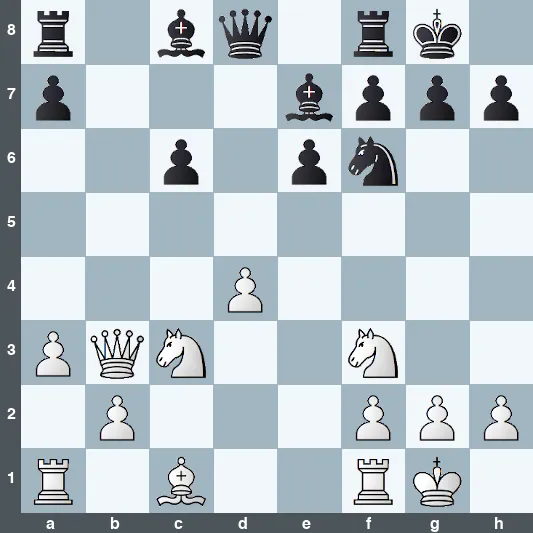
Posición #2: Un delicado equilibrio: las blancas tienen más espacio, pero las negras tienen la pareja de alfiles.
Me siento conforme con mi posición. Siguió 12... Dc7 13. Ae3 Tb8 14. Dc2 Ab7 15. Ca4!? Mi oponente se va por un juego técnico: ahora mismo amenaza con bloquear mi peón de c5 mediante Cc5 y creo que las cosas irían mal para mi sí eso ocurriera, pero es mi turno y algo debe poder hacerse (ver diagrama).

Posición #3: Aunque a los ojos humanos 15. Ca4 se ve bien, a jugadores de silicio no les gusta. No obstante, no necesitas ser una máquina para encontrar una buena forma de jugar con negras aquí. ¿Qué se te ocurre?
A mí se me ocurrió hacer 15... c5! yéndome por un juego táctico. Lo cómico es que la cuestión de los estilos está más bien invertida actualmente: yo soy un jugador técnico y mi antiguo rival, un jugador de ataque. En cuanto a la jugada, esta involucra sacrificar un peón evidentemente, pero a cambio de abrir la diagonal y activar a las piezas negras. No me conformé con ver 15... c5 solamente y calculé algunas plausibles ramificaciones. Ya veremos. Mi oponente capturó con 16. dxc5 (ver diagrama).
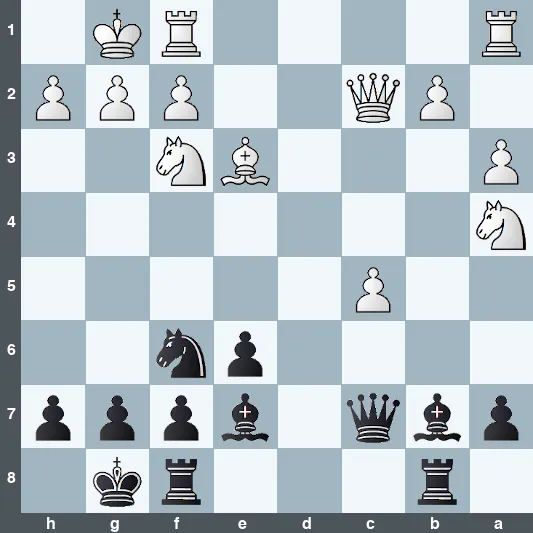
Posición #4: Ok, las negras abrieron la diagonal, ¿cuál es la continuación lógica?
Jugué 16... Cg4!? que envuelve un inocente truco, pero tambien amenaza al alfil. Esto es lógico, pero no menos lógico que la alternativa 16... Axf3! que al parecer da más serios chances al negro. Daña el enroque, pero no pude ver cómo sacarle más provecho, aunque por lo visto sí se podía haciendo la subsecuente 17... Ad6! que no alcancé a ver durante la partida. De allí que me fui por la otra jugada. Ahora el blanco juega 17. h3 necesariamente, de otro modo el negro hace Axf3 de manera mortal debido a la presión de mate sobre h2; un viejo truco.
Y ahora 17... Cxe3 Tras un largo tiempo de reflexión me decanté por esta captura. Estuve analizando 17... Axf3, pero tras 18. hxg4 debo jugar 18... Axg4 recuperando el peón, pero sentía que mis posibilidades de ataques se habían ralentizado ya que mi alfil cambió de diagonal. También valoré que las blancas tienen una mayoría de peones significativa en el flanco dama y sería muy peligroso para mí si mi ataque perdía impulso. Y parece que estoy en lo correcto, pues más de 14 años después, el módulo de análisis Stockfish 13 juzga que 17. Nxe3 es lo correcto, mientras que 17. Bxf3 habría dado clara ventaja al blanco.
Tras 18. fxe3 no me fue fácil mantener el ritmo o el juego preciso en la posición. Ahora hice 18... Tbc8? que no es muy buena. Hice esta jugada para inducir b4 de parte del blanco, tras lo cual podría en algun momento hacer Af6 y el caballo de a4 podría tener problemas para retroceder. Pero lo cierto es que con cálculo correcto el blanco debería sortear esa dificultad y reclamar una ventaja por el fuerte peón de c5. Era mejor para mí haber intentado 18 ..Aa6. Ahora 19. b4± (ver diagrama).
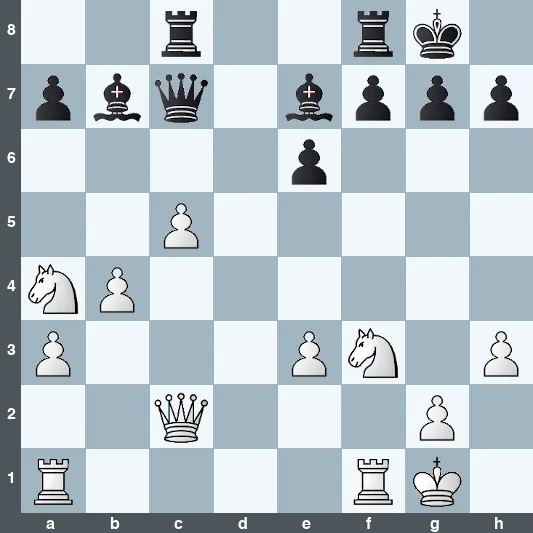
Posición #5: A pesar de la descoordinación, las blancas podrían consolidarse debido a la imprecisión del negro. El peón pasado y la mayoría de peones podrían ser una pesadilla, aunque para el blanco tampoco es fácil mantener el ritmo.
La partida continuó con 19... Dg3 20. Df2 Dg6 Estaba contando con esta posición para crear problemas. Solo necesito hacer Af6 y el caballo de a4 estaba aislado de la partida. Sin embargo, la idea funcionó porque mi oponente ahora mismo jugó 21. Ce5? lo cual fue muy impulsivo. Lo adecuado era jugar 21. Tad1! y tras 21... Af6 entonces 22. Td7 con juego complicado. EL punto está en que 22... Ac6? falla por 23. Txa7, y aunque las negras quedan activas tras 23... Ta8, las blancas deberían ser capaces de mantener todo bajo control.
La partida siguió con 21... De4! y el negro tiene un grado de actividad decente. Esto era exactamente lo que yo estaba buscando. Tras 22. Cf3 las blancas perdieron un importante tiempo. Tomar en f7 era muy arriesgado porque el caballo quedaría clavado y la dama, sobrecargada. Siguió 22... Af6 23. Tac1 Tcd8 24. Cc3 Dd3 Las negras está cada vez más activas. Las blancas podrían haberse salido con las suyas si habrían jugado con precisión de computadora, con jugadas tales como Cb2 o Tb1 anteriormente. Incluso aquí tienen caminos para mantener una ventaja a los ojos de la máquina, pero a los ojos humanos no es fácil, y tras el fastidio que provocaron mis piezas, las blancas cometieron un error garrafal. Jugaron: 25. Tfd1?? (ver diagrama).
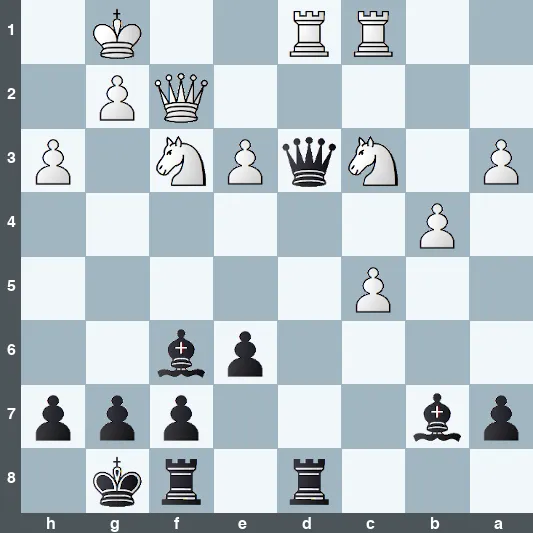
Posición #6: 25. Tfd1 parece natural, pero en el ajedrez lo natural no es siempre lo correcto. Ok, ¿Cómo se come esto?, ¿qué debe hacer el negro?
Las negras hacen la espectacular 25... Dxc3!! Es siempre un deleite sacrificar la dama con estilo y precisión, dado que su alteza es la pieza de mayor valor entre tus tropas. Perderla sin nada a cambio es siempre el peor negocio posible, pero aquí entregar la dama funciona perfectamente. Siguió 26. Txc3 Txd1+ Este es uno de los puntos: la torre blanca cuelga y con jaque. 27. Rh2 Axc3 Las negras han tomado dos torres y una pieza menor por la dama. Esto es demasiado. Y ahora 28. Dc2 (ver diagrama).

Posición #7: Ok, las blancas encuentran este tenedor y parece que recuperarán algo. ¿Será cierto?
¡No, no es cierto! Las negras disponen de 28... Axf3 y esto mantiene la ventaja, ya que si 29. gxf3, entonces 30. Td2+ gana la dama, evidentemente, por lo que las blancas deben conformarse con jugar 29. Dxc3 que es la jugada única y tras 29... Ac6−+ la ventaja material es ganadora para el negro. Todo esto tuvo que haber sido calculado en la partida al momento de sacrificar la dama.
Con todo, las blancas no se rindieron aún, ya que hay trabajo técnico por hacer. 30. Dc4 Ad5?! Esto fue impreciso de mi parte. Yo había valorado que tras 30... Td2, entonces 31. e4 seguido de b5, pero omití que yo podría hacer 31... Tfd8 y tendría buenos recursos que oponer, manteniendo un juego fluido.
Las blancas usan la oportunidad para molestar a su oponente 31. Dc2. Esto me invita a jugar Ta1 para continuar con Ta2 o tomar en a3. De allí que el blanco hace 32. e4 Ta2 33. Dd3 y está frustrando mis ideas. Ahora tengo que hacer 33... Ab7 tras lo cual el blanco dispone de 34. b5! y esto supone un problema importante para mí. Yo quería rematar limpiamente, pero fui descuidado. Ahora las blancas poseen una mayoría de peones móvil con una cuña en c5 y eso molesta bastante. Al ver que c6 era inminente decidí tomar medidas drásticas, pero fueron erróneas. Hice 34... f5? con idea de activar mis piezas lo más pronto posible, pero no debería funcionar bien (ver diagrama).
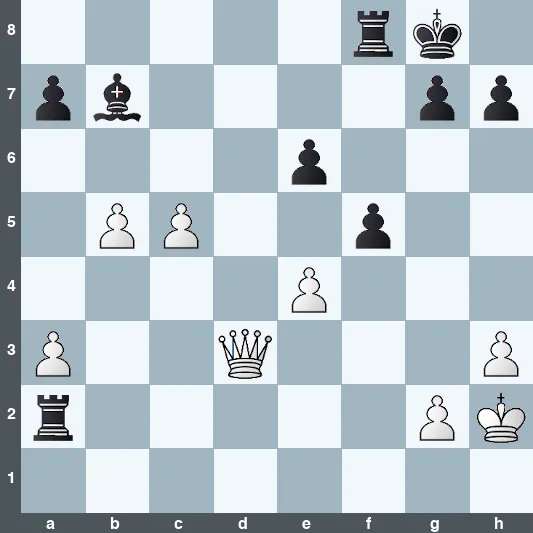
Posición #8: Las blancas estaban perdidas pero han tratado de ser tenaces. Ahora mismo poseen un rayo de esperanza. ¿Cómo deben jugar?
Las blancas no acertaron. Jugaron 35. c6? dejando pasar por alto la posibilidad de haber hecho más bien 35. Dc4! o 35. Db3! con un doble ataque sobre la torre y el peón e6 y ello debió dar dolores de cabeza al negro en sus deseos para ganar. De hecho, según la computadora, las blancas deben tener suficiente para unas tablas allí.
Siguió 35... Ac8 36. e5!? No era lo mejor, pero las blancas quieren mantener a mi alfil restringido. Ahora hago 36... f4! buscando a toda costa abrir líneas para coordinar mis piezas. Esta parte fue un poco oscura, con altibajos de parte mía y suya. No recuerdo bien si estábamos apurados de tiempo o sencillamente no podríamos jugar como grandes maestros. Continuó 37. Rg1 g6?! "Mejorar al rey" era innecesario. Mi técnica no fue perfecta aquí y mi oponente lo está medio aprovechando. 38. Rf1?! aunque no sin devolverme el favor. En algún momento esta jugada de rey traicionará al blanco. 38... Rg7 Era mejor 38. ...f3!
Y ahora 39. Db3! Td2 40. Db4 La dama va a inflitrarse en el territorio enemigo y dar problemas. 40... Tfd8 41. De7+ = Y he aquí la dama intrusa. Lamentablemente esto es, objetivamente hablando, suficiente para el empate. No obstante, en mi ambición no quise aceptar las tablas y decidí seguir jugando, esperando un error de mi contrario. Siguió 41... Rh6 42. Dh4+ Rg7 43. De7+ y ahora decidí variar con 43... Rg8 dejando a mi oponente con una posición límite: es él quien debe hacer las jugadas que mantienen el balance, pero para mi fortuna él falló y ahora hizo 44. Dxa7? con lo cual tengo una segunda oportunidad de tratar de imponer mi superioridad de fuerzas. Era mejor para el blanco hacer 44. a4 para tratar de generar un peón pasado en el flanco dama, ya que mis torres no se pueden inflitrar fácilmente al tener que vigilar los efectos de la dama intrusa. Pero ahora con la dama en a7, está muy alejada y me permite liberarme (ver diagrama).
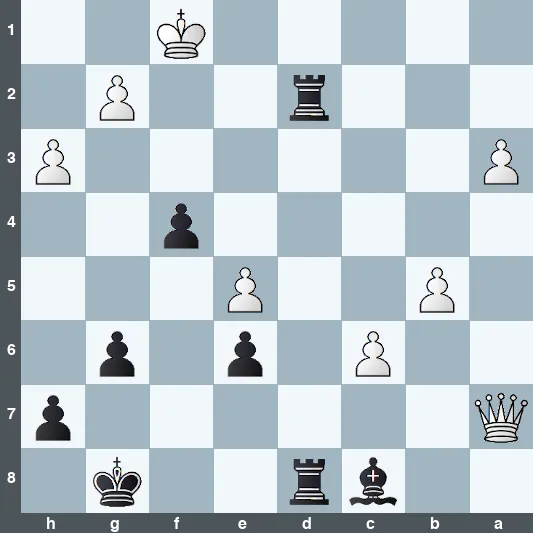
Posición #9: Las negras han conseguido una segunda oportunidad de obtener ventaja decisiva. ¿Qué deben hacer?
Pueden hacer la mortal 44... Tb2! que subraya los problemas del blanco por haber jugado 38. Rf1?! hace un rato. Habría sido una historia diferente si el rey blanco se hubiese mantenido en la esquina mejor, rodeado de sus peones. Con mi jugada se amenaza Td1 mate, por lo que el blanco hace 45. Re1 y ahora la sencilla 45... Txb5−+ simplifica el trabajo de las negras grandemente. Tomar este peón ha sido importante, ya que ahora los peones desconectados del blanco no plantean ningún problema. Siguió 46. Dc7 Tbd5 Consolidación. 47. Rf2 Aa6 ¡Ahora mi alfil de libera! 48. Rf3 Tf8 49. De7 Txe5 y tras esto mi oponente se rindió (ver diagrama).

Posición #10: La ventaja material negra es demasiada y los peones pasados blancos son fáciles de controlar y capturar. Es desesperanzador.
Es una lástima, pero al final el blanco fue quien se equivocó de último. Tuvo su oportunidad de mantener el equilibrio pero no fue fácil. Esta victoria me dio impulso ya que tumbé a uno de mis más cercanos competidores en el torneo.
Si tienes algún análisis, pregunta o sugerencia, compártelo en los comentarios y si quieres ver la reproducción de la partida, mira este genial GIF animado de lichess.org:

Dejo por acá transcripción de la partida en formato PGN. Si manejas software de ajedrez, será de gran utilidad:
[Event "Clasificatorio Estadal 2007"]
[Site "Coro, Teatro Armonía"]
[Date "2007.??.??"]
[Round "?"]
[White "Gutiérrez, Jhonattan"]
[Black "Revilla, Oniel"]
[Result "0-1"]
[Annotator "Oniel, Revilla"]
[ECO "B14"]
[EventCountry "VEN"]
[PlyCount "98"]
1. e4 c6 2. d4 d5 3. exd5 cxd5 4. c4 Nf6 5. Nc3 e6 6. Nf3 Bb4 7. Qb3 Nc6 8. a3
dxc4 9. Bxc4 Be7 10. Bb5 O-O 11. Bxc6 bxc6 12. O-O Qc7 13. Be3 Rb8 14. Qc2 Bb7
15. Na4 c5 16. dxc5 Ng4 17. h3 Nxe3 18. fxe3 Rbc8 19. b4 Qg3 20. Qf2 Qg6 21.
Ne5 Qe4 22. Nf3 Bf6 23. Rac1 Rcd8 24. Nc3 Qd3 25. Rfd1 Qxc3 26. Rxc3 Rxd1+ 27.
Kh2 Bxc3 28. Qc2 Bxf3 29. Qxc3 Bc6 30. Qc4 Bd5 31. Qc2 Ra1 32. e4 Ra2 33. Qd3
Bb7 34. b5 f5 35. c6 Bc8 36. e5 f4 37. Kg1 g6 38. Kf1 Kg7 39. Qb3 Rd2 40. Qb4
Rfd8 41. Qe7+ Kh6 42. Qh4+ Kg7 43. Qe7+ Kg8 44. Qxa7 Rb2 45. Ke1 Rxb5 46. Qc7
Rbd5 47. Kf2 Ba6 48. Kf3 Rf8 49. Qe7 Rxe5 0-1👉 Y por último, por si no te has enterado, aprovecho para invitarte a los torneos de ajedrez que se están realizando por iniciativa de jugadores y comunidades en la blockchain, tales como @schamangerbert, @stayoutoftherz y @chessbrotherspro. Visita sus perfiles para conseguir más información. Sinceros agradecimientos a ellos por la iniciativa y a @fulldeportes y @theycallmedan por su bievenido apoyo a los contenidos sobre ajedrez.
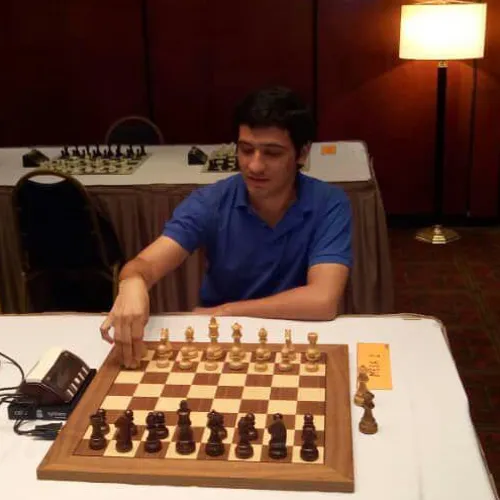
Sobre el autor:
Soy Oniel Revilla (@eniolw), un ajedrecista venezolano con título de Candidate Master otorgado por la Federación Internacional de Ajedrez (FIDE) en 2016. Poseo más de 20 años de experiencia como deportista y más de 10 años de experiencia como instructor y entrenador de ajedrez. También soy profesor en la Universidad Nacional Experimental Francisco de Miranda. Puedes aprender más sobre mi faceta ajedrecística en esta publicación.
Nota: A menos que se haya indicado lo contrario, las imágenes y vídeos en este post son del autor, eso incluye los diagramas, los cuales son renderizado propio. El gif animado es renderizado de lichess.org.
MY CHESS GAMES: An encounter with an old rival (Gutiérrez, Jhonattan vs Revilla, Oniel)
(English Version | Versión en inglés)

This post is part of a series dedicated to the unpublished release of a portion of my chess games that I have played throughout my career. These consist, for the most part, of competition and tournament games, as well as selected friendly games, training games, simul games, etc. They will be imported into lichess.org and also posted here on the blockchain, aspiring with this to leave an indelible trace of their existence.
These posts will, of course, include my own annotations, analyses and reviews of games in my capacity as a chess player and coach. By their nature, most of the analyses will require the reader to have some knowledge of chess, but in many cases just knowing chess notation should be sufficient. Their content is sure to prove useful to studious chess players (professional or amateur) and I am glad to know that you can come to the blockchain and #FullDeportes to check them out.
An encounter with an old rival
The game we are about to see was played in 2007 at the historic Ernesto Guevara chess school located at the Teatro Armonía in Coro, Falcón state, Venezuela. The tournament was one of the most important that the chess school had the honor of hosting since, although it was a local and qualifying tournament, it managed to bring together for two weekends many of the best chess players in the state, who for various reasons had not played a tournament together in quite some time.

Me during the regional qualifying tournament for the National Games of Los Llanos 2007, which I had the pleasant occasion to win in solitaire, being an experience that I treasure very much in my career. I was playing at the first board, and it's such a coincidence that I'm sitting next to the opponent I had in the game of this post.
My opponent is Jhonattan Gutierrez, who at the time was coming back from a retirement from chess for a few years and, being my contemporary, was my main rival in our category. Nowdays you can follow him on Lichess with the account Jhonattan2106. The game was key because it turns out that Jhonattan was one of the strongest players present and, in fact, he finished the tournament tied for second place. Let's take a look at the game.
1. e4 c6 The Caro Kann Defense was my main weapon with Black at that time. I was notably influenced by Anatoli Karpov, the most famous exponent of this defense, although the first time I saw it was in the "infamous" game between Deep Blue and Kasparov where the human champion lost. 2. d4 d5 3. exd5 cxd5 4. c4 This is the Panov attack, my opponent's weapon of choice. 4... Nf6 5. Nc3 e6 The alternative is to play 5.... Nc6, but I like the one in the game better.
It continued with 6. Nf3 Bb4 7. Qb3?! This is a sideline that promises nothing for white. However, I can't say that I was not surprised, since I was not an opening theoritician at the time. Nowadays I wonder if white understood the position as a kind of Capablanca's variation in the Nimzo-Indian. It is best to continue with 7. cxd5 Nxd5 8. Bd2 which has been tested thousands of times. The game continued with 7.... Nc6 8. a3 and well, white evidently wants to force matters, but that doesn't work well... in theory (see diagram).

Position #1: La jugada 8. a3 es teóricamente inofensiva y las negras pueden sacarle jugo de forma muy específica. ¿Cuál?
8... dxc4 certainly not like this. I didn't hit the move order approved by theory. The best thing to do was to continue with 8... Bxc3+ 9. Qxc3 Ne4! and the key is that black can force a favorable ending by 10. Qc2 Qa5+! 11. Bd2 Nxd2 Nxd2 12. Qxd2 Qxd2+ 13. Rxd2 Na5! (threatening Nb3+) 14. Kc3 dxc4 15. Bxc4 Nxc4 16. Nxc4 b6! and black has a better pawn structure and a better combination of pieces for this ending. In any case I don't feel so sorry about my decision because I definitely wanted to win with black, so I decided to keep more pieces on the board by avoiding an early simplification. It continued 9. Bxc4 Be7 10. Bb5!? O-O 11. Bxc6 bxc6 12. O-O We have a double-edged position (see diagram).

Position #2: A delicate balance: white has more space, but black has the bishop pair.
I feel comfortable with my position. It continued with 12... Qc7 13. Be3 Tb8 14. Qc2 Bb7 15. Na4!? My opponent goes for a technical game: right now he threatens to block my c5 pawn by Nc5 and I think things would go badly for me if that happened, but it's my turn and something must be able to be done (see diagram).

Position #3: Although to human eyes 15. Na4 looks good, silicon players don't like it. However, you don't need to be a machine to find a good way to play black here. What do you come up with?
I came up with 15... c5! and went for a tactical game. The funny thing is that the issue of styles is rather the opposite these days: I'm a technical player and my former opponent, an attacking player. As for the move, this involves sacrificing a pawn obviously, but in exchange for opening up the diagonal and activating the black pieces. I didn't settle for seeing 15... c5 only and calculated some plausible variations. We're going to see it. My opponent captured with 16. dxc5 (see diagram).

Position #4: Ok, black opened the diagonal, what is the logical continuation?
I played 16... Ng4!? which involves an innocent trick, but also threatens the bishop. This is logical, but no less logical than the alternative 16. Bxf3! which apparently gives black more serious chances. It damages the castle, but I could not see how to get more out of it, although apparently it could be done by the subsequent 17... Bd6! which I did not see during the game. So I went for the other move. Now white plays 17. h3 necessarily, otherwise black plays the deadly Bxf3 due to the mate threat on h2; an old trick.
And now 17... Nxe3 After a long think I went for this capture. I was analyzing 17... Bxf3, but after 18. hxg4 I'd have to play 18. Bxg4 regaining the pawn, but I felt that my attacking possibilities had slowed down since my bishop changed its diagonal. I also noticed that white has a significant pawn majority on the queenside and it would be very dangerous for me if my attack lost momentum. And it seems that I am correct, because more than 14 years later, the engine Stockfish 13 judges that 17. Nxe3 is correct, while 17. Bxf3 would have given white a clear advantage.
After 18. fxe3 it was not easy for me to keep pace or accurate play in the position. Now I moved 18... Rbc8? which is not very good. I made this move to provoke b4 from white, after which I could at some point make Bf6 and the knight on a4 might have trouble backing up. But the truth is that with correct calculation white should get around that difficulty and claim an advantage because of the strong pawn on c5. It was better for me to have tried 18 ...Ba6. Now 19. b4± (see diagram).

Position #5: Despite the lack of coordination, white could consolidate due to black's imprecision. The passed pawn and the majority of pawns could be a nightmare, although it's not easy for white to keep up the pace.
The game continued with 19... Qg3 20. Qf2 Qg6 I was counting on this position to create problems. I just need to make Bf6 and the knight on a4 was isolated from the game. However, the idea worked because my opponent right now played 21. Ne5? which was very impulsive. The proper thing to do was to play 21. Rad1! and after 21... Bf6 then 22. Rd7 with complicated play. The point is that 22... Bc6? fails because of 23. Rxa7, and although Black is left active after 23... Ra8, White should be able to keep everything under control.
The game continued with 21.... Qe4! and black has a decent degree of activity. This was exactly what I was looking for. After 22. Nf3 white lost an important tempo. Taking on f7 was very risky because the knight would be pinned and the queen, overloaded. It continues 22.... Bf6 23. Rac1 Rcd8 24. Nc3 Qd3 black is increasingly active. White could have gotten away with it if he had played with computer precision, with moves such as Nb2 or Rb1 earlier. Even here they have ways to maintain an advantage in the eyes of the machine, but in human eyes it's not easy, and after the nagging my pieces caused, white blundered. He played: 25. Rfd1? (see diagram).

Position #6: Rfd1 seems natural, but in chess natural is not always right. Ok, we need to chew this over, what should black do?
Black plays the spectacular 25... Qxc3! It's always a delight to sacrifice the queen with style and precision, since her highness is the most valuable piece among your troops. Losing it with nothing in return is always the worst possible deal, but here giving up the queen works perfectly. He followed with 26. Rxc3 Rxd1+ This is one of the points: the white rook hangs and with check. 27. Rh2 Bxc3 Black has taken two rooks and a minor piece for the queen. This is too much. And now 28. Qc2 (see diagram).

Position #7: Ok, white finds this fork and it looks like he's going to get something back. Is he?
No, he isn't! Black has 28... Bxf3 and this keeps the advantage, since if 29. gxf3, then 30. Rd2+ wins the queen, obviously, so white has to settle for 29. Dxc3 which is the only thing he has and after 29.... Bc6-+ the material advantage is winning for black. All this had to have been calculated in the game at the time of sacrificing the queen.
All in all, white did not give up yet, as there is technical work to be done. 30. Qc4 Bd5! This was inaccurate on my part. I had evaluated that after 30... Rd2, then 31. e4 followed by b5, but I missed that I could do 31... Rfd8 and I would have good resources to oppose, maintaining a fluid game.
White uses the opportunity to bother his opponent: 31. Qc2. This invites me to play Ra1 to continue with Ra2 or take on a3. So white makes 32. e4 Ra2 33. Qd3 and is frustrating my ideas. Now I have to make 33... Bb7 after which white has 34. b5! and this poses a major problem for me. I wanted to finish off cleanly, but I was careless. White now has a mobile pawn majority with a wedge on c5 and that's really annoying. After seen that c6 was looming I decided to take drastic measures, but they were wrong. I did 34. f5? with the idea of activating my pieces as soon as possible, but it shouldn't work well (see diagram).

Position #8: White is lost but is trying to be tenacious. Right now he has a glimmer of hope. How should he play?
White did not get it right. Qc4! or 35. Qb3! with a double attack on the rook and the e6-pawn and that should have given black headaches in his desire to win. In fact, according to the computer, white should have enough for a draw there.
The game continued with 35... Bc8 36. e5!? It wasn't the best, but White wants to keep my bishop restricted. Now I did 36... f4! looking at all costs to open lines to coordinate my pieces. This part was a bit dark, with ups and downs on mine and his part. I don't quite remember if we were short of time or simply couldn't play like grandmasters. He continued with 37. Kg1 g6! "Improving the king" was unnecessary. My technique was not perfect here and my opponent is kind of taking advantage of it. 38. Kf1?! though not without returning the favor to me. At some point this king move will betray white. 38... Kg7 It was better 38... f3!
And now 39. Qb3! Rd2 40. Qb4 The queen is going to infiltrate into enemy territory and cause trouble. 40... Rfd8 41. Qe7+ = And here is the intruding queen. Unfortunately this is, objectively speaking, enough for a draw. Nevertheless, in my ambition I did not want to accept a draw and decided to play on, hoping for a mistake by my opponent. It continued with 41... Kh6 42. Qh4+ Kg7 43. Qe7+ and now I decided to vary with 43.... Kg8 leaving my opponent with a borderline position: it is he who must make the moves that keep the balance, but to my fortune he failed and now played 44. Qxa7? with which I have a second chance to try to impose my superiority of forces. It was better for white to do 44. a4 to try to generate a passed pawn on the queenside, since my rooks cannot be easily inflitrated by having to watch out for the effects of the intruding queen. But now with the queen on a7, it is far away and allows me to free myself (see diagram).

Position #9: Black has got a second chance to gain a decisive advantage. What should he do?
He can play the deadly 44... Rb2! which underlines white's problems for having played 38. Kf1?! a while ago. It would have been a different story if white's king had stayed in the corner better, surrounded by his pawns. I'm threatening Rd1 checkmate now, so white does 45. Ke1 and now the simple 45... Rxb5-+ simplifies black's work greatly. Taking this pawn has been important, as now white's disconnected pawns pose no problem. It continued with 46. Qc7 Rbd5 Consolidation. 47. Kf2 Ba6 Now bishop is free! 48. Kf3 Rf8 49. Qe7 Rxe5 and after this my opponent resigned (see diagram).

Position #10: The black material advantage is too great and the white passed pawns are easy to control and capture. It's hopeless.
It's a pity, but in the end it was white who made the last mistake. He had his chance to keep the balance but it wasn't easy. This victory gave me momentum as I knocked down one of my closest competitors in the tournament.
If you have any analysis, questions or suggestions, share them in the comments and if you want to see the replay of the game, check out this cool animated GIF from lichess.org:.

I leave here a transcript of the game in PGN format. If you handle chess software, it will be very useful:
[Event "Clasificatorio Estadal 2007"]
[Site "Coro, Teatro Armonía"]
[Date "2007.??.??"]
[Round "?"]
[White "Gutiérrez, Jhonattan"]
[Black "Revilla, Oniel"]
[Result "0-1"]
[Annotator "Oniel, Revilla"]
[ECO "B14"]
[EventCountry "VEN"]
[PlyCount "98"]
1. e4 c6 2. d4 d5 3. exd5 cxd5 4. c4 Nf6 5. Nc3 e6 6. Nf3 Bb4 7. Qb3 Nc6 8. a3
dxc4 9. Bxc4 Be7 10. Bb5 O-O 11. Bxc6 bxc6 12. O-O Qc7 13. Be3 Rb8 14. Qc2 Bb7
15. Na4 c5 16. dxc5 Ng4 17. h3 Nxe3 18. fxe3 Rbc8 19. b4 Qg3 20. Qf2 Qg6 21.
Ne5 Qe4 22. Nf3 Bf6 23. Rac1 Rcd8 24. Nc3 Qd3 25. Rfd1 Qxc3 26. Rxc3 Rxd1+ 27.
Kh2 Bxc3 28. Qc2 Bxf3 29. Qxc3 Bc6 30. Qc4 Bd5 31. Qc2 Ra1 32. e4 Ra2 33. Qd3
Bb7 34. b5 f5 35. c6 Bc8 36. e5 f4 37. Kg1 g6 38. Kf1 Kg7 39. Qb3 Rd2 40. Qb4
Rfd8 41. Qe7+ Kh6 42. Qh4+ Kg7 43. Qe7+ Kg8 44. Qxa7 Rb2 45. Ke1 Rxb5 46. Qc7
Rbd5 47. Kf2 Ba6 48. Kf3 Rf8 49. Qe7 Rxe5 0-1👉 And finally, in case you haven't heard, I take this opportunity to invite you to the chess tournaments that are being run on the initiative of players and communities in the blockchain, such as @schamangerbert, @stayoutoftherz and @chessbrotherspro. Visit their profiles to get more information. Sincere thanks to them for the initiative and to @fulldeportes and @theycallmedan for their welcome support for chess content.

Sobre el autor:
I'm Oniel Revilla (@eniolw), a Venezuelan chess player with the title of Candidate Master awarded by the International Chess Federation (FIDE) in 2016. I have more than 20 years of experience as an professiona chess player and more than 10 years of experience as a chess coach. I am also a professor at the Universidad Nacional Experimental Francisco de Miranda. You can learn more about my chess facet in this post.
Note: Unless otherwise noted, the images and videos in this post belong to @eniolw, that includes the diagrams, which are rendered by myself. The animated gif is rendered from lichess.org.
▶️ 3Speak
